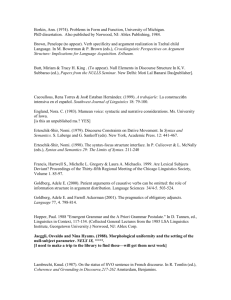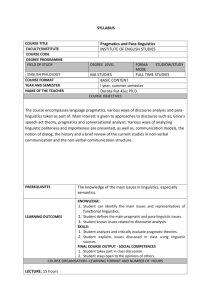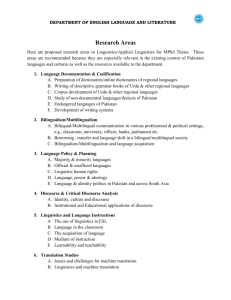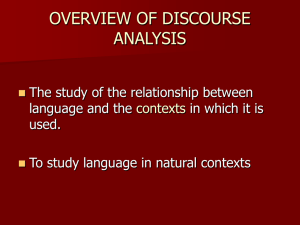Specific English DMs and DP References
advertisement
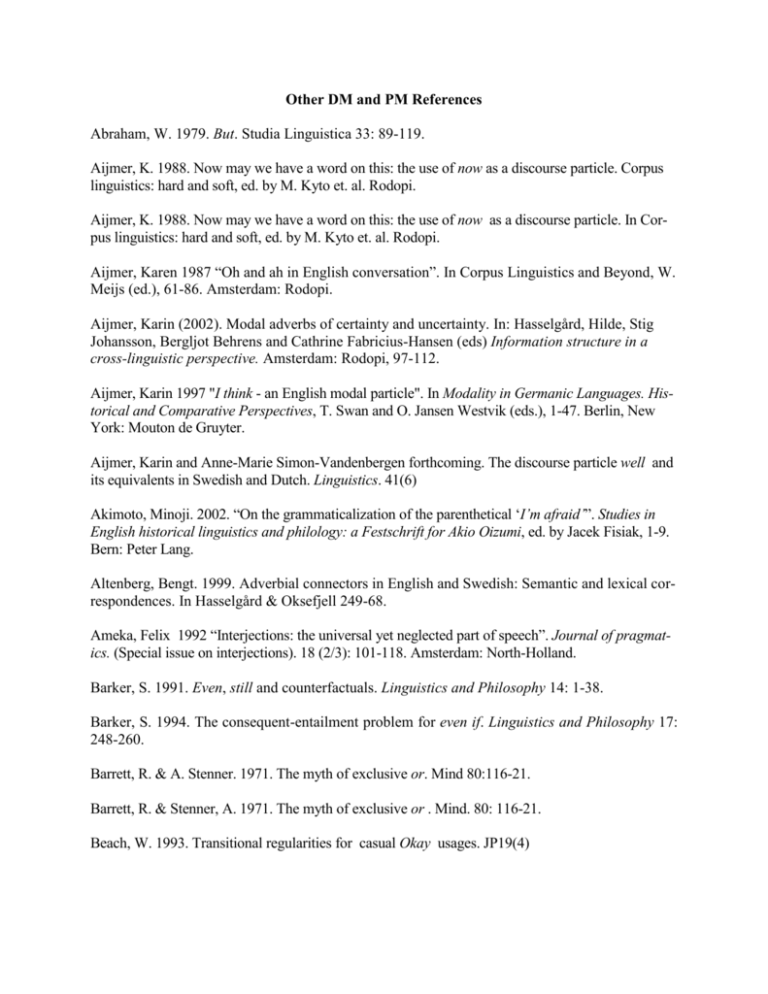
Other DM and PM References Abraham, W. 1979. But. Studia Linguistica 33: 89-119. Aijmer, K. 1988. Now may we have a word on this: the use of now as a discourse particle. Corpus linguistics: hard and soft, ed. by M. Kyto et. al. Rodopi. Aijmer, K. 1988. Now may we have a word on this: the use of now as a discourse particle. In Corpus linguistics: hard and soft, ed. by M. Kyto et. al. Rodopi. Aijmer, Karen 1987 “Oh and ah in English conversation”. In Corpus Linguistics and Beyond, W. Meijs (ed.), 61-86. Amsterdam: Rodopi. Aijmer, Karin (2002). Modal adverbs of certainty and uncertainty. In: Hasselgård, Hilde, Stig Johansson, Bergljot Behrens and Cathrine Fabricius-Hansen (eds) Information structure in a cross-linguistic perspective. Amsterdam: Rodopi, 97-112. Aijmer, Karin 1997 "I think - an English modal particle". In Modality in Germanic Languages. Historical and Comparative Perspectives, T. Swan and O. Jansen Westvik (eds.), 1-47. Berlin, New York: Mouton de Gruyter. Aijmer, Karin and Anne-Marie Simon-Vandenbergen forthcoming. The discourse particle well and its equivalents in Swedish and Dutch. Linguistics. 41(6) Akimoto, Minoji. 2002. “On the grammaticalization of the parenthetical ‘I’m afraid’”. Studies in English historical linguistics and philology: a Festschrift for Akio Oizumi, ed. by Jacek Fisiak, 1-9. Bern: Peter Lang. Altenberg, Bengt. 1999. Adverbial connectors in English and Swedish: Semantic and lexical correspondences. In Hasselgård & Oksefjell 249-68. Ameka, Felix 1992 “Interjections: the universal yet neglected part of speech”. Journal of pragmatics. (Special issue on interjections). 18 (2/3): 101-118. Amsterdam: North-Holland. Barker, S. 1991. Even, still and counterfactuals. Linguistics and Philosophy 14: 1-38. Barker, S. 1994. The consequent-entailment problem for even if. Linguistics and Philosophy 17: 248-260. Barrett, R. & A. Stenner. 1971. The myth of exclusive or. Mind 80:116-21. Barrett, R. & Stenner, A. 1971. The myth of exclusive or . Mind. 80: 116-21. Beach, W. 1993. Transitional regularities for casual Okay usages. JP19(4) 2 Bell, D. M. 1998. Cancellative discourse markers: A core/periphery approach. Pragmatics 8.4: 515-541. Biber, D. & E. Finnegan. 1988. Adverbial stance types in English. Discourse Processes 11:1-34. Birner, B. 1988, But as conventional implicature: identifying the source of contrast. Northwestern Working Papers in Linguistics, 1:16-28. Blakemaore, Diane. 1989. Denial and contrast: A relevance theoretic analysis of but. Linguistics and Philosophy 12:15-37. Blakemore, D. 1988. So as a constraint on relevance. In R.M. Kempson (ed.). Mental Representations. The interface between language and reality. Cambridge: Cambridge University Press, 183196. Blakemore, D. 1989. Denial and contrast: A relevance-theoretic analysis of but. Liguistics and Philosophy 12:15-37. Blakemore, D. 1989. Denial and contrast: A relevance-theoretic analysis of but. Liguistics and Philosophy 12:15-37. Blakemore, D. 2000. Indicators and procedures: nevertheless and but. Journal of Linguistics 36:463-486 Boguslawski, A. 1986. Also from all so: On a set of particles in service of efficient communication. JP 10: 615-33. Boguslawski, A. 1986. Also from all so: On a set of particles in service of efficient communication. JP 10:615-33. Carlson, L. 1984. 'Well' in dialogue games: A discourse analysis of the interjection 'well' in idealized conversation. Amsterdam: Benjamins. Condon, Sharon 1986 “The Discourse Functions of OK”. Semiotica 60: 73-101. 3 Condon, Sharon 2001 „Discourse ok Revisited: Default Organization in Verbal Interaction.“ Journal of Pragmatics 33, 491-513. Couper-Kuhlen, Elizabeth/ Kortmann, Bernd (Hg.) (2000): Cause - Condition - Concession - Contrast. Cognitive and Discourse Perspectives. Berlin, New York: de Gruyter (Topics in English Linguistics 33) Dascal, M. & T. Katriel. 1977. Between semantics and pragmatics: The two types of ‘but’ – Hebrew ‘aval’ and ‘ela’. Theoretical Linguistics 4: 143-172. Degand, Liesbeth (2000): Causal connectives or causal prepositions? In: Journal of Pragmatics 32 S. 687-707. Erman, B. 1987. Pragmatic Expressions in English: A study of you know, you see and I mean in Face-to-face Conversation. (Stockholm Studies in English 69). Stockholm: Almqvist&Wiksell. Erman, B. 1987. Pragmatic expressions in English: A study of you know, you see andI mean in face-to-face conversation. Almqvist and Wiksell Int. Erman, B. 2001. “Pragmatic markers revisited with a focus on you know in adult and adolescent talk”. JP 33, 1337-1359. Erman, Britt and Ulla-Britt Kotsinas. 1993. “Pragmaticalization: the case of ba’ and you know”. Studies i modern språkvetenskap. Stockholm: Almqvist & Wiksell. Erman, Britt. 1987. Pragmatic expressions in English: a study of you know, you see, and I mean in face-to-face conversation. Stockholm: Almqvist and Wiksell. Eulenberg, Alexander. 1995. But revisited. Unpublished ms, U of Indiana. Faerch, Claus and Gabriele Kasper. 1982. “Phatic, metalingual and metacommunicative functions in discourse: gambits and repairs”. Impromptu speech: a symposium, ed. by Nils Enkvist, 71-103. Åbo: Åbo Akademi. 4 Ferara, K. 1994. Sociolinguistic variation in discourse markers: the case of anyway, anyways, anyhow, at any rate. Paper presented at NWAV 23. Stanford University. Ferara, K. 1994. Sociolinguistic variation in discourse markers: the case of anyway, anyways, anyhow, at any rate. Paper presented at NWAV 23. Stanford University. Ferrara, Kathleen 1997"Form and function of the discourse marker anyway: Implications for discourse analysis". Linguistics 35: 343-378. Finell, a. (1989): Well Now and Then. In Journal of Pragmatics 13, 4. pp. 653-656. Finell, A. 1989. Well, now andthen. JP 13: 653-6. Finell, A. 1989. Well, now and then. JP 13: 653-6. Fischer, K. & Nemo, F., 2000, "Aber, Mais, But: Integrating Semantics, Grammar and Pragmatics". Working paper presented at SIC-CSP2000. Fleischman, Suzanne 1999. “Like” as discorse marker, Pragma99, Tel Aviv, unpublished. Fox Tree, J.E., & J.C. Schrock. 1999. Discourse markers in spontaneous speech: Oh what a difference an "oh" makes. Journal of Memory and Language 40, 280-295. Fox Tree, Jean and Josef C. Schrock 1999. “Discourse markers in spontaneous speech: Oh what a difference an oh makes”. Journal of Memory and Language 40: 280-295. Fraser 1999. The particle so in English. In RASK 9/10: 397-413. Fraser, B & M. Malamud-Makowski. 1996b. “English and Spanish contrastive discourse markers” Language Sciences 8 (3-4) 863-881. Also in K. Jaszczolt & K. Turner (eds.). Contrastive Semantics and Pragmatics. Vol. II: Discourse Strategies. Oxford: Elsevier Science Ltd., 363-881. Fraser, B. 2001 A View of English buts. In Festschrift for J-O Ostman. 5 Goddard, C. 1986. The natural semantics of too . JP 10: 635-643. Goddard, C. 1986. The natural semantics of too . JP 10: 635-643. Goldberg, J. 1980. Discourse particles: An analysis of the role of 'y'know', 'I mean', 'well' and 'actually' in conversation. Unpublished PhD dissertation, Cambridge University. Goldberg, J. 1980. Discourse particles: An analysis of the role of y'know, I mean, well and actually in conversation. Unpublished PhD dissertation, Cambridge University. Greasley, P. 1994. An investigation into the use of the particle well: Commentaries on a game of snooker. JP 22(5). Greasley, P. 1994. An investigation into the use of the particlewell: Commentaries on a game of snooker. JP 22(5). Green, G. 1968. On too and either and not just too and either, either. CLS 4. Green, G. 1968. On too and either and not justtoo and either, either. CLS 4. Gunter, R. 1984. The conjunctive system of English: A study of form and meaning. Language Sciences 6:1-29. Gupta, A. 1992. The pragmatic particles of Singaphore colloguial English. JP 18(1)31-57. Hamanchi, N. 1991. How well does well work in conversation? A unified approach. Studies in English 56:282-302. Hamanchi, N. 1991. How well does well work in conversation? A unified approach. Studies in English 56:282-302. Henkemans, F Snhoeck. 1995. ‘But’ as an indicator of counter-arguments and concessions. Leuvense Bijdragen 84: 6 Hill, D. Imprecatory interjectional expressions: Examples from Australian English. JP18:2 Hines, C. 1977. Well,... In The Fourth Lacus Forum ed. by M. Paradis. Hines, C. 1977. Well. In The Fourth Lacus Forum, ed. by M. Paradis. Hockey, b.a. (1988): The Function of Okay as a Cue Phrase in Discourse. Linguistics 605. University of Pennsylvania. Unpublished manuscript Holmes, j. (1986): Functions of you know in women’s and men’s speech. In Language in Society 15:1, pp. 1-22. Iten, C. 1997. Because and although: a case of duality? UCL Working Papers in Linguistics 9: 55-76. Iten, C. 1998a. Because and although: a case of duality? In Rouchota, V. & A. H. Jucker (eds.). Current Issues in Relevance Theory. 59-80. Amsterdam: John Benjamins. Iten, C. 1998b. The meaning of although: a relevance theoretic account. UCL Working Papers in Linguistics 10: 81-108. James, A. 1983. Compromisers in English: A cross-disciplinary approach to their interpersonal signficance. JP 3:219-38. James, D. 1978. The use of oh, ah, say, and well in relation to a number of grammatical phenomena. Papers in Lingusitics 11/3-4. James, D. 1978. The use of oh, ah, say, and well in relation to a number of grammatical phenomena. Papers in Lingusitics 11(3-4). Johnson-Laird, P. 1969. &. Journal of Linguistics 6: 111-114. Jucker, A. 1993 The marker well: A relevance-theoretical account. JP19:5 7 Jucker, A. H. 1993. The discourse marker well: A relevance theoretic account. JP 19, 435-452. Jucker, Andreas H. 1993 "The discourse marker well: A relevance theoretical account". Journal of Pragmatics 19: 435-452. Jucker, Andreas H. and Sara W. Smith. 1998. “And people just you know like ‘wow’: discourse markers as negotiating strategies”. Discourse markers: descriptions and theory, ed. by Andreas H. Jucker and Yael Ziv, 171-201. Amsterdam and Philadelphia: John Benjamins. Kaplan, J. 1984. Obligatory too in English. Lg 60:510-18. Kaplan, J. 1984. Obligatory too in English. Lg 60:510-18. Katriel, T. & M. Dascal. 1984 what do indicating devices indicate? Philosophy and Rhetoric 171:115 Lakoff, Robin. 1971. Ifs, ands and buts about conjunction. In Studies in Linguistics Semantics ed. by C. Fillmore and T. Langendoen. Holt, Reinhart & Winston, New York, 115-50. Lipar, L. 1994. Subjectification: The case of in fact. Ms, Stanford Univ. Lipar, L. 1994. Subjectification: The case of in fact. Ms, Stanford Univ. May 2005 May 2005 Merritt, M. 1984. On the use of okay in service encounters. In J. Baugh & J. Sherzer (eds.), Language in use. Prentice-Hall. Merritt, M. 1984. On the use of okay in service encounters. Language in use, ed. by J. Baugh & J. Sherzer. Prentice-Hall. 8 Murray, d. (1979): Well. In Linguistic inquiry 10, 4.. Cambridge, Mass: MIT Press, pp. 727-732 Murray, D. 1979. Well. Linguistic Inquiry 10:727-32. Murray, D. 1979. Well. Linguistic Inquiry, 10: 727-32. Norrick, N. (1995): Hunh-tags and evidentiality in conversation. In Journal of Pragmatics 23, pp. 687-692. Östman, J.-O. 1981. You know: A discourse-functional approach. Amsterdam: John Benjamins. Östman, Jan-Ola 1981.You know: A discourse-functional approach. Amsterdam / Philadelphia: John Benjamins. Östman, J-O. 1981. You know: A discourse functional approach. Benjamins. Owen, m. (1981): Conversational Units and the Use of Well... In Werth, P. (ed): Conversation and Discourse Structure and Interpretation. London: Croom Helm, pp. 99-116. References on Specific English DMs and DPs REFERENCES ON SPECIFIC ENGLISH DMS AND DPS Rouchota, V. 1990. ‘But’: Contradiction and relevance. UCL Working Papers in Linguistics 2: 65-81. Rouchota, V. 1990. But: Contradiction and relevance. UCL Working Papers in Ling. 2, 65-81. Sadock, J. 1981. Almost. In Radical pragmatics, ed, by P. Cole. Acad. Press. Sadock, J. 1981. Almost. Radical pragmatics, ed. by P. Cole. Acad. Press. Salkie, R. 1996. The “all but” construction. E-mail posting, Linguistic List 7-1559. 9 Schegloff, 1981. Discourse and conversation: Uh huh and other things that come between sentences. GURT, 1982. Schegloff, 1981. Discourse and conversation: Uh huh and other things that come between sentences. GURT, 1982. Schiffrin, D. 1985. Conversational coherence: The role of well. Lg 61:640-667. Schiffrin, D. 1985. Conversational coherence: The role of well. Lg. 61: 640-667. Schiffrin, D. 1986. Functions of and in discourse. JP 10:41-66. Schiffrin, D. 1986. Functions of and in discourse. JP 10:41-66. Schiffrin, D. 1987 Discourse markers. Cambridge: CUP. Schiffrin, D. 1987. Discourse Markers. CUP Schiffrin, D. 1992. Anaphoric then: aspectual, textual, and epistemic meaning. Linguistics 30(4):753-92. Schiffrin, D. 1992. Anaphoric then:: aspectual, textual, and epistemic meaning. Linguistics, 30(4):753-92. Schleppegrell, M. 1991. Paratactic because. JP 16(4):323-37. Schleppegrell, M. 1991. Paratactic because. JP 16(4):323-37. Schmerling. S. 1975. Asymmetric conjunction and rules of conversation. In Cole & Morgan (eds.), Syntax and Semantics: Speech Acts,1975. Schourup, L. 1985. Common discourse particles in English conversation: like, well, y´ know. New York: Garland. 10 Schourup, L. 1999. Discourse markers. Lingua 107: 227-265 Schreiber, P. A. 1971. Some constraints on the formation of English sentence adverbs. Linguistic Inquiry, 2: 83-101. Sidiropoulou, M. 1992. On the connective although. JP 17: 201-221. Sidiropoulou, M. 1992. On the connective although. JP 17:210-221 Sidiropoulou, M. On the connective although.. JP17:3 Simon-Vandenberge, Anne-Marie and Karin Aijmer. forthcoming. The expectation marker of course in a cross-linguistic perspective. Languages in Contrast Simon-Vandenbergen, Anne-Marie. 2000. The functions of I think in political discourse. International Journal of Applied Linguistics 10 (1): 41-63. Snoeck, F. 1995. “But” as an indicators of counterarguments and concessions. Leuvense Bijdragen 84. Stentrîm, A-B. 1987. Right, alright and ok in spoken interaction. Stentrîm, A-B. 1987. Right, alright and ok in spoken interaction. Svartvik, J. 1980. Well in conversation. In S. Greenbaum, G. Leech & J. Svartvik (eds.). Studies in English Linguistics for Randolph Quirk. London: Longman, 16770-177. Svartvik, J. 1980. Well in conversation. Studies in English linguistics for Randolph Quirk. 167-77. Longman. Sweetser, E. E. 1990. From Etymology to Pragmatics. Metaphorical and Cultural Aspects of Semantic Structure. Cambridge: CUP. 11 Takahara, p.o. (1998): Pragmatic Functions of the English Discourse Marker anyway and its Corresponding Contrastive Japanese Discourse Markers. In Jucker, A.H. and Ziv, Y. (ed): Discourse Markers.Descriptions and Theory. Pragmatics and Beyond 57, New Series. Amsterdam/Philadelphia: John Benjamins, pp. 327-351. Tanaka, Hiroaki. 1997. In other words and conversational implicature. Pragmatics 7 (3), 367-387. Traugott, Elizabeth. 1994. UNLESS and BUT conditionals; A historical perspective. Proceedings of the Duisburg Symposium on Conditionals ed. by Angeliki Athenasiadou and Rene Dirven. Mouton de Gruyter. Valentine, T. 1991. Getting the message across: discourse markers in Indian English. World Englishes, 10(3): 325-34. Van der Auwera, Johan 1993 “Already and still: Beyond duality.” Linguistics and philosophy 16: 613-653. van Dijk, T. 1979. Pragmatic connectives. JP 3: 447-456 Ward G. 1993 The samantics and pragmatics of and everything . JP19:3 Ward G. 1993 The samantics and pragmatics of and everything. JP 19:3 Watts, R. 1989 Taking the pitcher to the 'well': Native speakers' perception of their use of discourse markers in conversation. JP 13:2 Watts, R. 1989 Taking the pitcher to the 'well': Native speakers' perception of their use of discourse markers in conversation. JP13:2 Watts, R. J. 1986. Relevance in conversational moves: a reappraisal of well. Studia Anglica Posnaniensia 19, 37-59. Werner, R. 1985. Discourse connectives in English. Garland. 12 White, W. 1974. Like as a conjunction. American Speech, 49(1/2): 156-8. White, W. 1974. Like as a conjunction. American Speech 49(1/2):156-8. Wickboldt, J.M., 1997. The Semantics of since. Doctoral Dissertation, Indiana University. Wierzbicka, A. 1986a. Precision in vagueness: The semantics of English approximatives'. J of Pragmatics, 10: 597-613.



